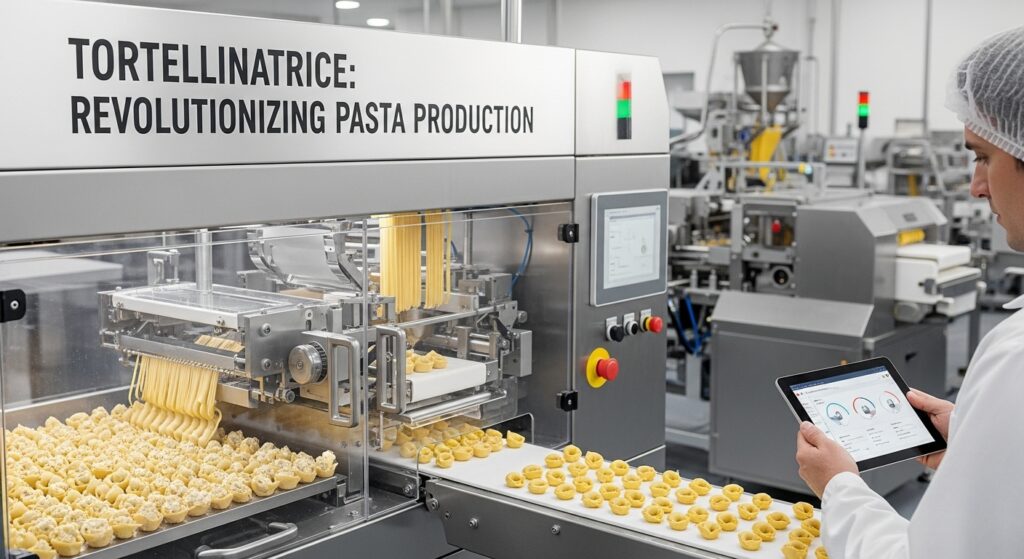The tortellinatrice represents a remarkable evolution in the art of pasta making. Derived from the Italian word “tortellini,” this machine has become a cornerstone in both artisanal and industrial pasta production. A tortellinatrice is designed to craft perfect tortellini — those small, ring-shaped pasta parcels filled with meat, cheese, or vegetables — with unmatched consistency and speed.
In a world where culinary tradition meets modern engineering, the tortellinatrice stands as a perfect blend of heritage and technology. Whether used in small pasta shops in Bologna or large-scale factories across Europe, it has redefined how tortellini are produced, maintaining quality while increasing efficiency.
The Origin and Purpose of the Tortellinatrice
Italian Roots and Culinary Heritage
Italy’s Emilia-Romagna region is known as the birthplace of tortellini. Traditionally, each tortellino was hand-shaped by skilled artisans who spent years mastering the craft. However, as demand grew, maintaining consistency became a challenge. That’s when the tortellinatrice emerged — to preserve the tradition of tortellini while adapting to the needs of modern production.
Purpose and Function
The tortellinatrice automates the process of cutting, filling, and shaping pasta dough into tortellini. The machine ensures uniformity in size and texture, allowing producers to create thousands of perfect pieces in just a few minutes. Despite its automation, it never compromises on authenticity — the end result remains as flavorful and visually appealing as handmade tortellini.
Components and Structure of the Tortellinatrice
A tortellinatrice consists of several crucial components that work harmoniously to deliver precision and efficiency. Below is a table outlining the main parts and their functions:
| Component | Function |
|---|---|
| Dough Feeder | Continuously supplies pasta dough to the rolling and cutting section. |
| Filling Unit | Deposits the desired filling into each pasta segment. |
| Molding Rollers | Shape the dough and seal the tortellini to ensure proper closure. |
| Cutter System | Cuts each tortellino to precise size and design. |
| Conveyor Belt | Transports the finished pasta pieces for drying or packaging. |
| Control Panel | Allows users to adjust speed, filling quantity, and dough thickness. |
Each of these components plays a vital role in producing high-quality tortellini, maintaining both taste and visual appeal.
How the Tortellinatrice Works
The tortellinatrice operates through a streamlined process combining automation with precision. First, the dough is flattened and shaped into a continuous sheet. Simultaneously, the filling mixture — often made from ricotta, prosciutto, or spinach — is injected between the layers of dough.
Next, the rollers press and cut the dough into uniform tortellini shapes. The molding section ensures that each piece is properly sealed to retain its filling during cooking. Finally, the tortellini are transferred onto a conveyor belt for drying, freezing, or immediate packaging.
This process allows for a production rate that far exceeds manual methods while preserving the traditional shape and texture beloved by pasta enthusiasts.
Key Features of the Modern Tortellinatrice
Modern tortellinatrice models are equipped with advanced features that enhance performance and adaptability. Some of the key features include:
-
Adjustable Filling Settings: Enables producers to vary the filling ratio depending on recipe requirements.
-
Stainless Steel Body: Ensures hygiene, durability, and easy maintenance.
-
Automatic Lubrication System: Reduces friction and wear, prolonging machine lifespan.
-
Digital Control Interface: Allows operators to fine-tune production speed, pressure, and dough thickness.
-
Energy Efficiency: Designed to minimize electricity consumption while maximizing output.
These features make the tortellinatrice a powerful tool for both small pasta artisans and large food manufacturers.
Advantages of Using a Tortellinatrice
1. Consistency and Quality
Unlike manual production, a tortellinatrice ensures each tortellino is identical in size, weight, and sealing. This consistency enhances cooking performance and presentation.
2. Speed and Efficiency
The machine drastically reduces production time, enabling large quantities of tortellini to be made in hours instead of days.
3. Cost-Effectiveness
By automating key stages, the tortellinatrice minimizes labor costs while increasing overall productivity.
4. Hygiene and Safety
Since the pasta dough and filling are handled within a closed system, contamination risks are significantly reduced.
5. Versatility
Modern machines can be adjusted to create different types of filled pasta, such as ravioli, cappelletti, and agnolotti, expanding business opportunities.
Comparing Handcrafted and Machine-Made Tortellini
| Aspect | Handcrafted Tortellini | Tortellinatrice-Made Tortellini |
|---|---|---|
| Production Speed | Slow and manual | Fast and automated |
| Consistency | Varies by artisan skill | Uniform and precise |
| Labor Cost | High | Low |
| Authentic Taste | Traditional flavor and texture | Nearly identical to handmade |
| Scalability | Limited to small batches | Suitable for industrial production |
This comparison shows that while handcrafted tortellini hold sentimental value, the tortellinatrice provides scalability without compromising on authenticity.
The Role of the Tortellinatrice in Modern Food Production
In today’s competitive food industry, maintaining both quality and efficiency is essential. The tortellinatrice plays a crucial role in achieving this balance. It empowers small-scale producers to meet high demand without sacrificing craftsmanship and enables large manufacturers to deliver traditional Italian flavors to global markets.
Moreover, technological advancements have made modern machines more compact and affordable, allowing even family-run pasta shops to integrate them into daily production. This democratization of technology ensures the survival of Italy’s pasta heritage while adapting it to modern standards.
Maintenance and Longevity of the Tortellinatrice
Proper maintenance is key to the long-term performance of a tortellinatrice. Regular cleaning after each production cycle prevents dough buildup and bacterial growth. Lubricating moving parts, inspecting rollers for wear, and ensuring filling units remain calibrated are also vital steps.
A well-maintained tortellinatrice can last over a decade, making it a valuable investment for any pasta business. Manufacturers often provide detailed maintenance guides and spare part support, ensuring consistent performance and product quality.
Choosing the Right Tortellinatrice
When selecting a tortellinatrice, producers should consider factors such as:
-
Production Volume: Small shops may prefer compact tabletop models, while industrial factories require large-capacity systems.
-
Filling Type: Machines differ in how they handle soft or dense fillings.
-
Material and Build Quality: Stainless steel construction ensures hygiene and durability.
-
Ease of Operation: Digital control panels and automation settings simplify use for beginners.
-
After-Sales Support: Reliable customer service and availability of spare parts ensure uninterrupted production.
Choosing wisely guarantees smooth operations and a consistent product line.
Future Innovations in Tortellinatrice Technology
The future of the tortellinatrice lies in smart automation and sustainability. AI-driven quality control systems are being developed to monitor shape accuracy and filling uniformity in real time. Some new models also feature energy-saving technologies and modular designs that can adapt to different pasta shapes with minimal downtime.
These innovations are set to make the tortellinatrice even more indispensable in the food industry, maintaining the delicate balance between Italian tradition and modern efficiency.
Conclusion
The tortellinatrice is more than a machine; it’s a bridge between Italy’s culinary past and its technological future. It has preserved the artistry of tortellini-making while enabling global accessibility to authentic Italian pasta.
From small artisanal workshops to large-scale manufacturing plants, the tortellinatrice continues to revolutionize how pasta is produced, proving that automation can coexist harmoniously with tradition.
As the world’s appetite for authentic Italian cuisine grows, the tortellinatrice stands as a shining example of innovation driven by passion — a testament to how craftsmanship and technology can create perfection, one tortellino at a time.






